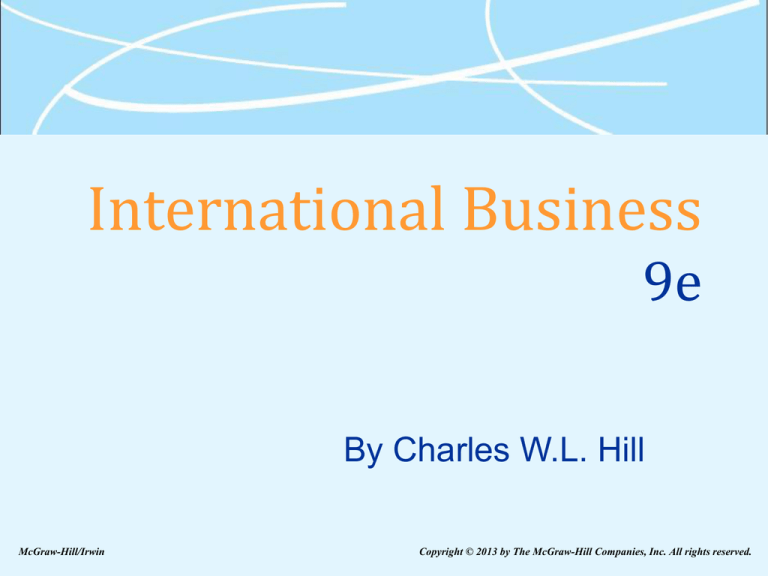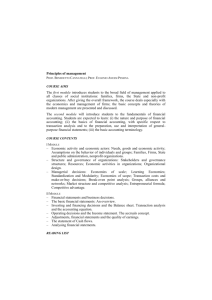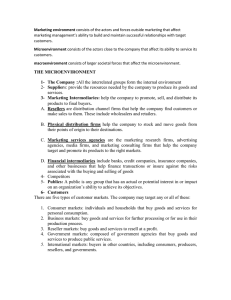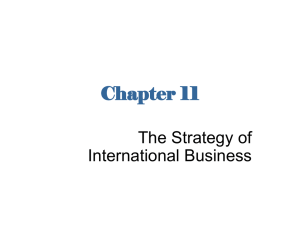
International Business
9e
By Charles W.L. Hill
McGraw-Hill/Irwin
Copyright © 2013 by The McGraw-Hill Companies, Inc. All rights reserved.
Chapter 13
The Strategy of International
Business
What Is Strategy?
A firm’s strategy refers to the actions that
managers take to attain the goals of the firm
Firms need to pursue strategies that increase
profitability and profit growth
Firms can
add value
lower costs
sell more in existing markets
expand internationally
13-3
What Is Strategy?
Determinants of Enterprise Value
13-4
How Is Value Created?
The firm’s value creation is the difference between V and
C
a firm has high profits when it creates more value for
its customers and does so at a lower cost
Profits can be increased by
1. Using a differentiation strategy
2. Using a low cost strategy
To maximize long run return on invested capital firms
pick a viable position on the efficiency frontier, configure
internal operations to support that position, have the right
organization structure in place to execute the strategy
13-5
How Is Value Created?
Value Creation
13-6
How Are A Firm’s
Operations Configured?
A firm’s operations are like a value chain
composed of distinct value creation activities
Primary activities
R&D
production
marketing and sales
customer service
Support activities
information systems
logistics
human resources
13-7
How Are A Firm’s
Operations Configured?
The Value Chain
13-8
How Can Firms Increase Profits
Through International Expansion?
1.
2.
3.
International firms can
Expand their market
Realize location economies
Realize greater cost economies from
experience effects
4. Earn a greater return
13-9
How Can Firms Leverage Their
Products And Competencies?
The success of firms that expand
internationally depends on
the goods or services sold
the firm’s core competencies
Core competencies allow firms to reduce
the costs of value creation and/or to create
perceived value so that premium pricing is
possible
13-10
Why Are Location
Economies Important?
By achieving location economies, firms
can
lower the costs of value creation and achieve
a low cost position
differentiate their product offering
Firms that take advantage of location
economies in different parts of the world,
create a global web of value creation
activities
13-11
Why Are Experience
Effects Important?
The experience curve - the systematic
reductions in production costs that occur over
the life of a product
by moving down the experience curve, firms reduce
the cost of creating value
Learning effects - cost savings that come from
learning by doing
Economies of scale - the reductions in unit cost
achieved by producing a large volume of a
product
13-12
What Competitive Pressures
Exist In The Global Marketplace?
Firms that compete in global markets face two
conflicting types of competitive pressures
limit the ability of firms to realize location economies
and experience effects, leverage products, and
transfer skills within the firm
1. Pressures for cost reductions
force the firm to lower unit costs
2. Pressures to be locally responsive
require the firm to adapt its product to meet local
demands in each market, but raise costs
13-13
When Are Pressures Greatest?
Pressures for cost reductions are greatest
1. For firms producing products that fill universal needs
2. When major competitors are in low cost locations
3. Where there is persistent excess capacity
4. Where consumers are powerful and face low
switching costs
Pressures for local responsiveness arise from
1. Differences in consumer tastes and preferences
2. Differences in traditional practices and infrastructure
3. Differences in distribution channels
4. Host government demands
13-14
Which Strategy
Should A Firm Choose?
There are four basic strategies to
compete in international markets
1.
2.
3.
4.
the appropriateness of each strategy
depends on the pressures for cost reduction
and local responsiveness in the industry
Global standardization
Localization
Transnational
International
13-15
How Does Strategy Evolve?
An international strategy may not be viable in the
long term
to survive, firms may need to shift to a global
standardization strategy or a transnational strategy in
advance of competitors
Localization may give a firm a competitive edge,
but if the firm is simultaneously facing
aggressive competitors, the company will also
have to reduce its cost structures
would require a shift toward a transnational strategy
13-16
How Does Strategy Evolve?
Changes in Strategy over Time
13-17











